Alaska, also known as The Last Frontier, is located in the northwest extremity of North America and is the largest state by area in the US. The state is known for its extremely varied climate. Parts of Alaska feature an oceanic climate, other subpolar oceanic, dry-summer subarctic, tundra, warm-summer mediterranean continental, and so on.
When it comes to fauna, there are about 1,100 vertebrate species that occur regularly in this state. Some 112 mammal species, such as whales, bears, birds, moose, grey wolves, and impressive marine life, can be found here.
Naturally, it is worth looking at the state’s (distant) past. For instance, the state was underwater for the entirety of the Paleozoic, Triassic, and Jurassic eras. It was only during the Cretaceous period that Alaska emerged from the depths.
Given this, let’s discover 8 extinct animals that lived in Alaska and populated this cold area!
1. Ichthyosaurs
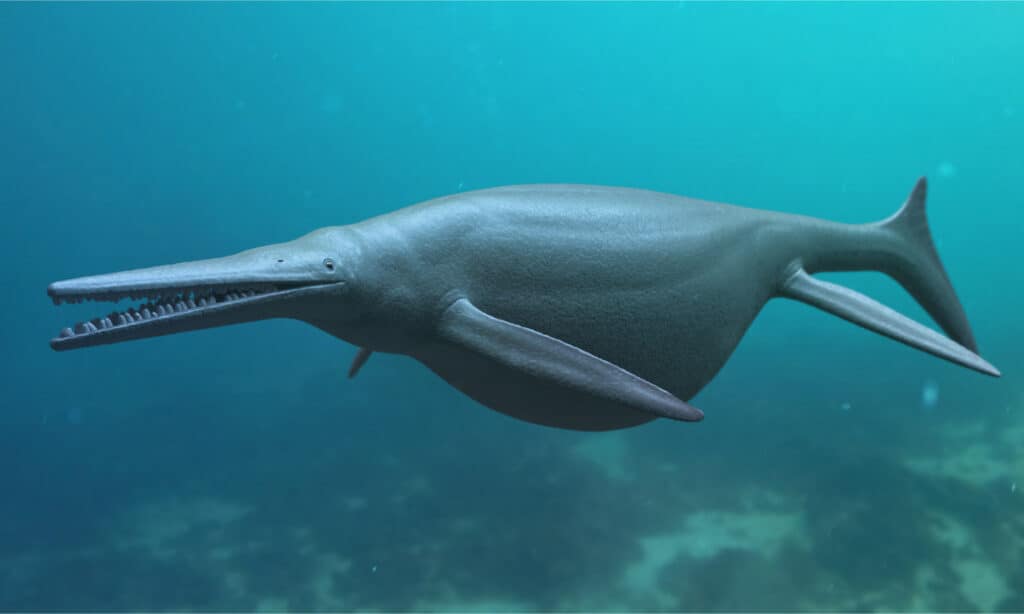
Ichthyosaurs were large marine reptiles that lived in Alaska’s territory during the Triassic period.
©Giant Ichthyosaurus Aquatic Dinosaur 3D Rendered/Shutterstock.com
| Ichthyosaurs | |
|---|---|
| Kingdom | Animalia |
| Phylum | Chordata |
| Class | Reptilia |
| Clade | Eoichthyosauria |
| Order | Ichthyosauria |
| Extinct since | 90 million years ago |
Ichthyosaurs, meaning “fish lizard” in Ancient Greek, were large marine reptiles that lived in Alaska’s territory during the Triassic period. They are the top aquatic predators of the Late Triassic and Early Jurassic periods. However, they were replaced by the Plesiosauria. The ichthyosaurs went extinct about 90 million years ago.
Ichthyosauria is an order of the extinct Eoichthyosauria clade. As such, many genera, families, and parvorders need to be considered. Each family came with its aspect. For instance, the Stenopterygius resembled today’s dolphin. Most other ichthyosaurs looked like common marine mammals but were larger.
The extinct order of animals featured specimens of about 6.6 to 13.1 feet (2-4 m) long on average. Some ichthyosaurs were shorter than 1 ft (0.3 m), while some were larger. For instance, several fragmentary finds point to ichthyosaurs of 49 feet (15 m) and 66-82 feet (20–25 m) in length.
2. Ammonites
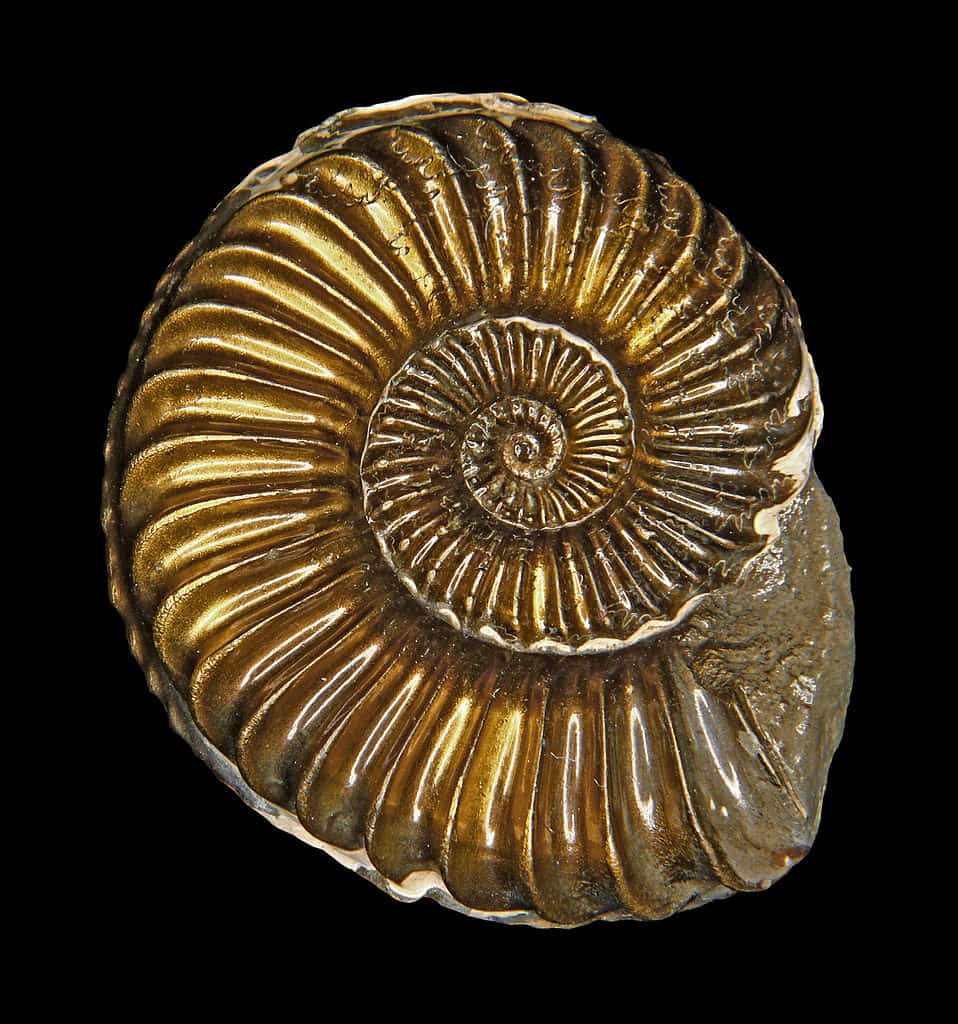
Ammonites went extinct about 66 million years ago.
©Llez (H. Zell) / CC BY-SA 3.0 – License
| Ammonites | |
|---|---|
| Kingdom | Animalia |
| Phylum | Mollusca |
| Class | Cephalopoda |
| Subclass | Ammonoidea |
| Extinct since | 66 million years ago |
Ammonites were part of the local marine life of Alaska during the Devonian and Permian periods. Despite their shelled appearance, these extinct mollusks are closely related to today’s squid, octopuses, and cuttlefish. Ammonites went extinct about 66 million years ago, during or shortly after the Cretaceous-Paleogene extinction event.
The fossils of this extinct animal can be identified by their coiled ram horn look. It is believed that ammonites lived in open water and that they were good swimmers as well. Ammonites might have been equipped with ink squirting capabilities, as ink is often found in fossils.
They come in various shapes and sizes with regard to their shell. The shell of the ammonites features multiple, progressively larger chambers. These were divided by thin walls and could be filled with gas on-demand to maintain buoyancy. The living animal inhabited only the shell’s last and largest chamber.
3. Inoceramus
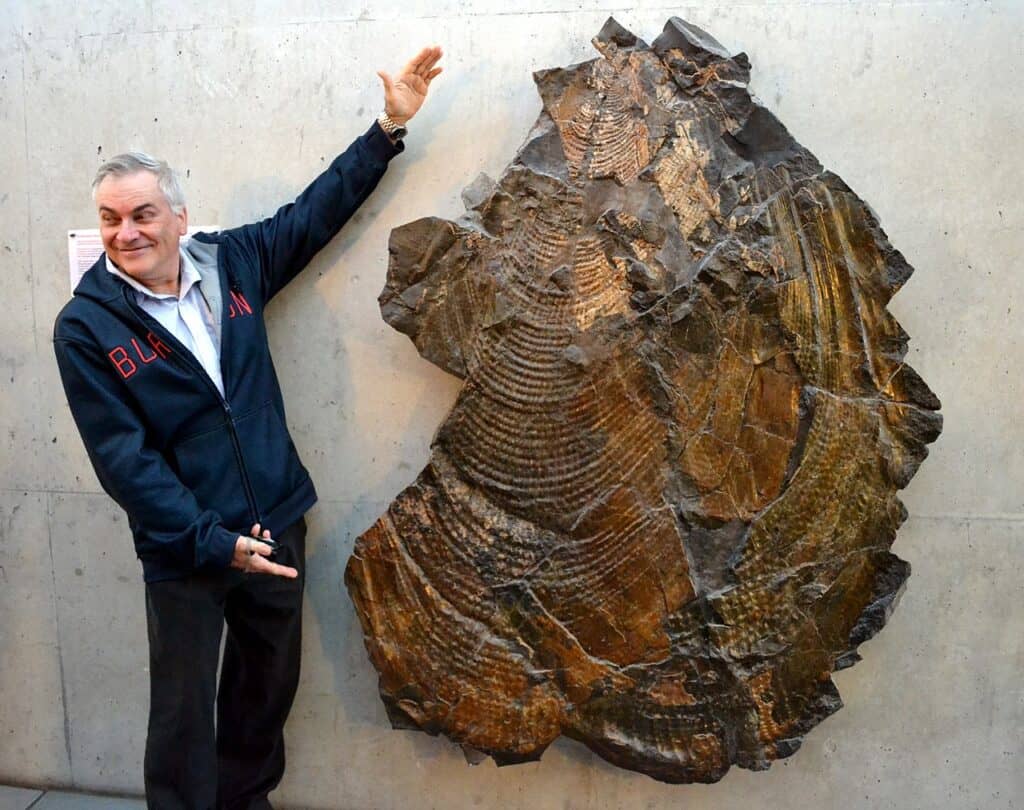
are characterized by their thick shells made of
calcite prisms.
©Mike Beauregard from Nunavut, Canada / CC BY 2.0 – License
| Inoceramus | |
|---|---|
| Kingdom | Animalia |
| Phylum | Mollusca |
| Class | Bivalvia |
| Order | Pteriida |
| Family | Inoceramidae |
| Genus | Inoceramus |
| Extinct since | 66 million years ago |
The Inoceramus are marine pteriomorphian bivalves. In short, they are the prehistoric version of today’s mollusks and saltwater clams. In fact, Inoceramus are known for resembling, more or less, winged pearly oysters. According to research, at least five species of Inoceramus were present in Alaska’s territory during the Cretaceous period. The genus went extinct around 66 million years ago.
Inoceramus are characterized by their thick shells made of calcite prisms. The largest discovered specimen belongs to the Inoceramus steenstrupi species and measures 74 inches (187 cm) across. In Alaska, Inoceramus fossils were found scattered throughout the entire state.
The genus was present worldwide during the Cretaceous and Jurassic periods. However, a large number of fossils are found in parts of North America and in the Gault Clay of England. There are at least 67 discovered species in this genus.
4. Woolly mammoth
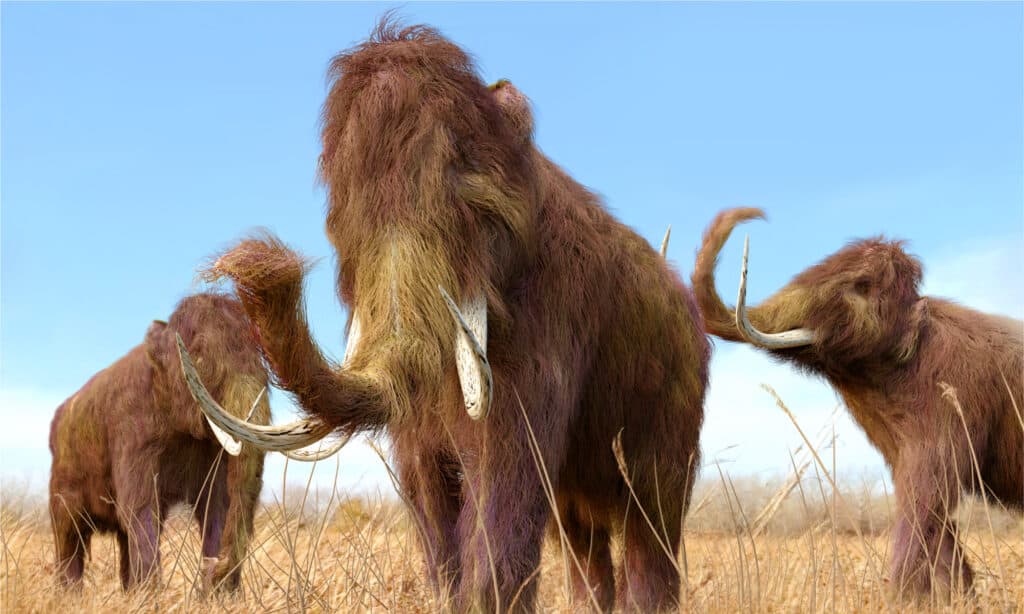
The woolly mammoth lived in the same period as the early humans.
©Aunt Spray/Shutterstock.com
| Woolly mammoth | |
|---|---|
| Kingdom | Animalia |
| Phylum | Chordata |
| Class | Mammalia |
| Order | Proboscidea |
| Family | Elephantidae |
| Genus | Mammuthus |
| Species | Mammuthus primigenius |
| Extinct since | 37,000 years ago |
Mammuthus primigenius, better known as the woolly mammoth of the Pleistocene period, is the state fossil of Alaska. This particular species was one of the last of its line, going extinct around 37,000 years ago. The wooly mammoth was an impressive animal, even though it was the same size as the modern African elephant. This is due to its tusks and coat.
In terms of size, Mammuthus primigenius has a shoulder height of about 8.9–11.2 feet (2.7–3.4 m) and could be as heavy as 6 metric tons. A newborn mammoth calf weighed around 200 lb (90 kg).
The woolly mammoth lived in the same period as the early humans. This is why mammoth tusks and bones are often found in prehistoric dwellings, tools, and even art. Even though most woolly mammoth populations went extinct around 37,000 years ago, isolated groups were documented on St. Paul Island until 5,600 years ago (and in a couple of other locations). This led to some researchers suggesting that the woolly mammoth is not, in fact, extinct and that isolated populations still inhabit the Northern Hemisphere tundra.
5. Spectacled cormorant
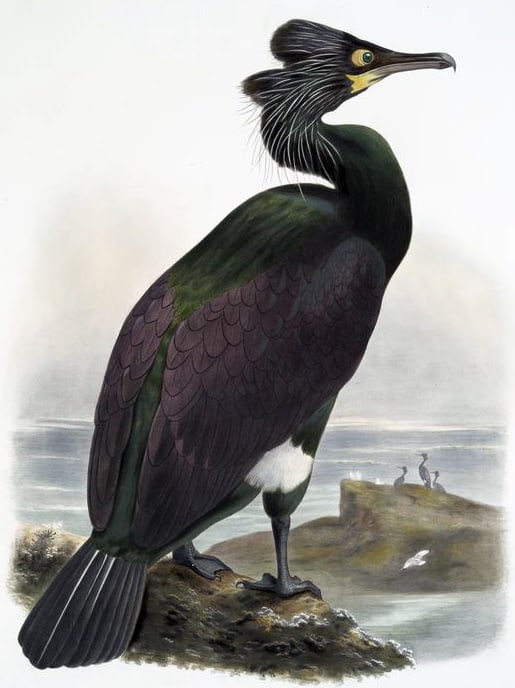
The spectacled cormorant is an extinct marine bird that used to inhabit Bering Island.
©Joseph Wolf / public domain – License
| Spectacled Cormorant | |
|---|---|
| Kingdom | Animalia |
| Phylum | Chordata |
| Class | Aves |
| Order | Suliformes |
| Family | Phalacrocoracidae |
| Genus | Urile |
| Species | Urile perspicillatus |
| Extinct since | 1850 |
Urile perspicillatus, also known as the spectacled cormorant, is an extinct marine bird that used to inhabit Bering Island, certain areas of the Komandorski Islands, the coast of Kamchatka, and Alaska. However, it is worth noting that the species’ fossils were also discovered in Japan.
The spectacled cormorant is the largest cormorant species ever discovered. The animal could reach a length of 39 inches (100 cm) and a weight of 7.7 to 15 lb (3.5-6.8 kg). The weight is the main reason the species is often considered almost flightless. Its reduced sternum and wing chord, noticed in museum specimens, suggest that this species might have lost its power of flight in time.
The species is presumed to have gone extinct in 1850. George Steller, the naturalist who discovered it, is reportedly the only person to see Urile perspicillatus alive.
6. Steller’s sea cow

The first specimen of Steller’s sea cow was found between Alaska and Russia in the Bering Sea.
©Nicolas Primola/Shutterstock.com
| Steller’s sea cow | |
|---|---|
| Kingdom | Animalia |
| Phylum | Chordata |
| Class | Mammalia |
| Order | Sirenia |
| Family | Dugongidae |
| Genus | Hydroamalis |
| Species | Hydrodamalis gigas |
| Extinct since | 1768 |
Hydrodamalis gigas, better known as Steller’s sea cow, is an extinct siren. Sirenians are aquatic herbivorous animals that live in rivers, swamps, estuaries, coastal marine waters, and marine wetlands. This species lived from the Pleistocene period until 1768, when it went extinct. The first specimen of Steller’s sea cow was found between Alaska and Russia in the Bering Sea.
In terms of size, Steller’s sea cow could reach lengths of up to 30 feet (9m) and weigh around 8 to 10 tons. The species didn’t have any true teeth. Instead, it had white bristles that it used to feed on kelp.
According to research, this species was positively buoyant. This means that it wasn’t able to submerge completely. As such, it had developed a thick outer skin of around 1 inch (2.5 cm) that would prevent injuries caused by ice and sharp rocks found at surface level.
7. Dire wolf
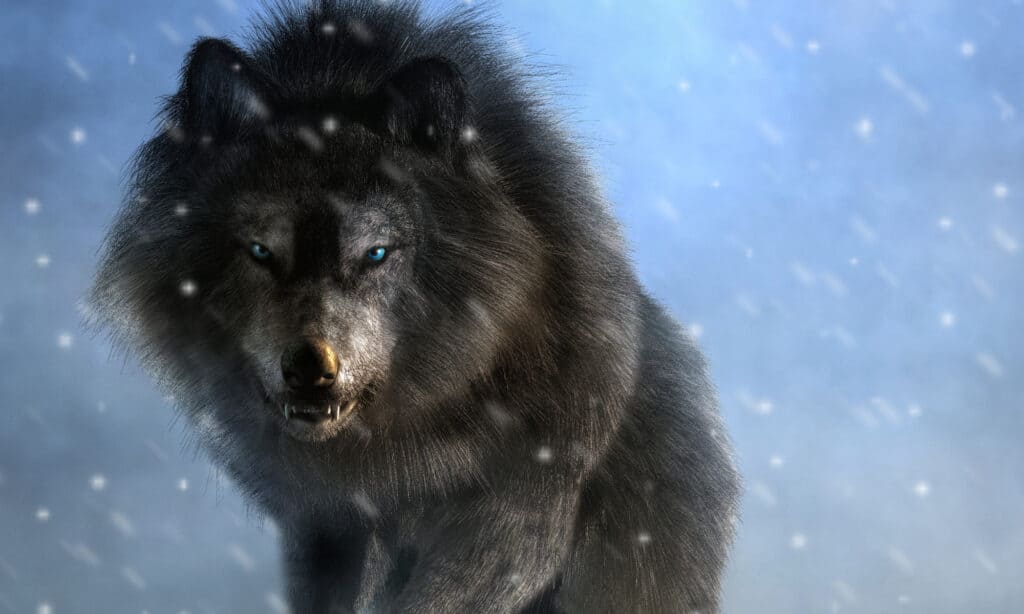
The dire wolf is known for its incredibly strong bite force – the strongest in the
Canisspecies.
©Daniel Eskridge/Shutterstock.com
| Dire wolf | |
|---|---|
| Kingdom | Animalia |
| Phylum | Chordata |
| Class | Mammalia |
| Order | Carnivora |
| Family | Canidae |
| Subfamily | Caninae |
| Tribe | Canini |
| Subtribe | Canina |
| Genus | Aenocyon |
| Species | Aenocyon dirus |
| Extinct since | 9,500 years ago |
Another Alaskan animal was Aenocyon dirus, better known as the dire wolf. This species is an extinct canine that lived during the Late Pleistocene and Early Holocene periods. It went extinct around 9,500 years ago. The dire wolf was a highly adaptable species, as its fossils were found across the Americas. For example, fossils were found in North America’s mountainous areas and South American savannas.
Aenocyon dirus was similar to Canis lupus (the modern gray wolf) in size. The dire wolf is known for its incredibly strong bite force – the strongest in the Canis species. Its diet consisted mainly of ancient bison, western horses, mastodons, ground sloths, and camels, depending on the area it inhabited.
8. Long-horned bison
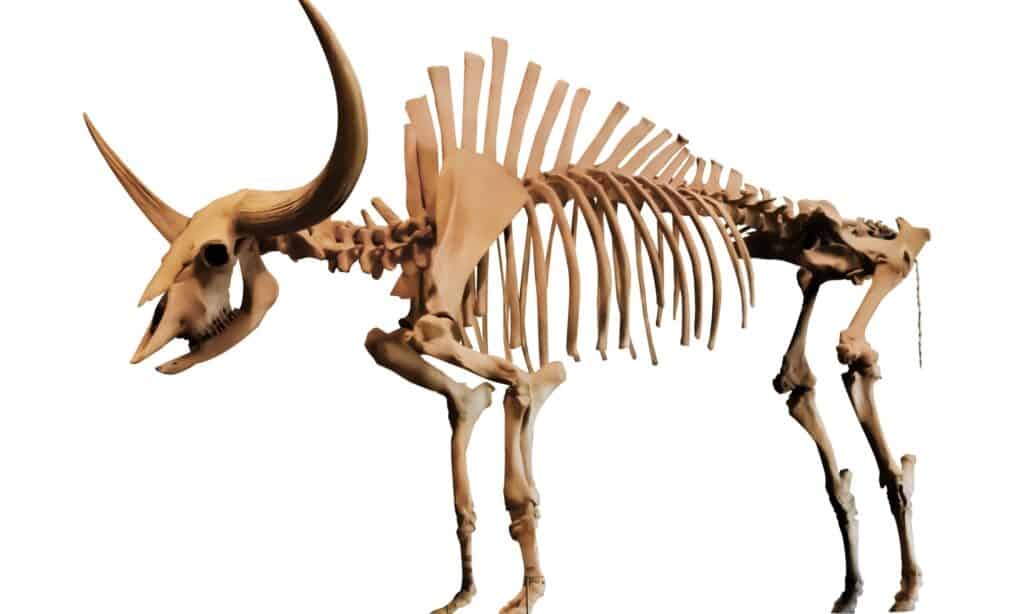
The long-horned bison is a species of bison that inhabited certain parts of North America, including Alaska, during the Pleistocene period.
©iStock.com/barbaraaaa
| Long-horned bison | |
|---|---|
| Kingdom | Animalia |
| Phylum | Chordata |
| Class | Mammalia |
| Order | Artiodactyla |
| Family | Bovidae |
| Subfamily | Bovinae |
| Genus | Bison |
| Species | Bison latifrons |
| Extinct since | 20,000-30,000 years ago |
Bison latifrons, the long-horned or giant bison, is a species of bison that inhabited certain parts of North America, including Alaska, during the Pleistocene period. It is known as the largest and heaviest member of the Bovidae family to have ever lived in the region of North America. It went extinct about 20,000–30,000 years ago.
It is worth mentioning that the size of Bison latifrons is more or less deduced from discovered fossils of skulls and horns. These types of fossils were the only ones found in a well-preserved state. The horns of a long-horned bison measure, on average, up to 84 inches (213 cm). In comparison, the horns of the modern bison can grow only as big as 35 inches (90 cm).
The photo featured at the top of this post is © Daniel Eskridge/Shutterstock.com
Thank you for reading! Have some feedback for us? Contact the AZ Animals editorial team.






